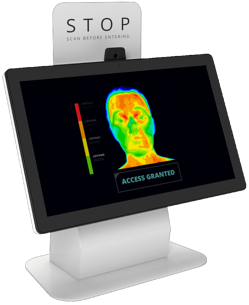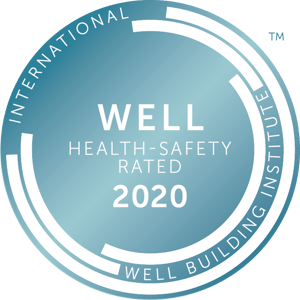How to Keep Your Workplace Healthy From COVID-19 and Other Illnesses
If your business maintains healthy buildings, employees are likely to remain fit and productive. This article explains how to keep the workplace...
How a healthy building can keep your office, employees, and visitors safe from COVID-19 and other illnesses.
The novel coronavirus has set up camp, dug in, and no one knows when it will leave. Some researchers say that even when it does leave, it’s certain to visit us again this winter. COVID-19 is more than just a human health pandemic affecting millions of people across the globe, too; it is also causing enormous ramifications to the global economy and businesses everywhere.
Mandatory business closures are expiring, or are set to expire soon. In the face of that, business leaders must grapple with how to reopen. For now, the effects of COVID-19 are an evolving situation, and there are many implications for companies. The virus is a human tragedy, but its legacy is certain to change how we work – perhaps for good.
Conducting business as usual during worktime will henceforth often be directly at odds with staying healthy in the wake of the pandemic. We are now encouraged to follow social distancing measures that are designed to keep us healthy. That is tough to do, especially since everything from attending school to working in a meatpacking plant, to attending all-hands meetings at huge corporations, is designed to huddle us closely together.
One of the business types mentioned above that has employees working shoulder to shoulder is already buckling under the strain of its current design. According to USA Today, the novel coronavirus has closed several meatpacking plants across the United States, and the rash of closures may be worse than we know. Since COVID-19 struck the US, plant operators have often found themselves making the difficult decision between worker health and providing meat to stores.
 The trend is alarming, and the fallout from the coronavirus threatens to hobble other businesses that aren’t designed to fight it. This is a wide-reaching problem of huge proportions, as it can affect national and global supply chains. With COVID-19 forcing changes to our daily lives, along with the way we conduct business, many owners have been left scrambling for answers.
The trend is alarming, and the fallout from the coronavirus threatens to hobble other businesses that aren’t designed to fight it. This is a wide-reaching problem of huge proportions, as it can affect national and global supply chains. With COVID-19 forcing changes to our daily lives, along with the way we conduct business, many owners have been left scrambling for answers.
The overall fix won’t include only the temporary measures that grocery stores are using now, either, such as safe distancing. Such measures are merely short-term Band-aid fixes that are easily circumvented. Instead, the answer is to design for a healthier workforce, which must take into account social distancing and other proactive measures. And, while we’re still just beginning to understand what the new normal will look like after COVID-19, one recent and promising emerging trend is healthy buildings.
The rest of this post provides an overview of the concept of healthy buildings and how this can apply to the modern workplace. Although Greetly serves mostly offices, they also work with retailers, manufacturing facilities, and more. Hence, we refer to all these buildings as “workplaces.”
Before we continue, it’s important that you know that the outbreak is evolving rapidly. Some of the business perspectives discussed here may not apply later. This article reflects our perspectives as of April 14, 2020.
A healthy building, as its name implies, is designed to promote the health and wellness of the individuals who occupy it. In a broad sense, healthy buildings are constructed to include a wide range of concepts and applications that promote human health and wellness.
There are nine foundations of high-level components that exist for healthier buildings. These include proper management of ventilation, noise, air quality, dust and pests, water quality, thermal health, safety and security, lighting and views, and moisture.
Other features of a healthy building include, but are not limited to, biophilic design, healthy dining options, exercise in the workplace, site selection, and smoking restrictions. Because of the global pandemic, you can expect to see a rise in the usage of these healthy building techniques, along with additional measures targeting safety from the virus to diffuse throughout the economy.
On average, Americans spend approximately 90 percent of their daily lives cooped up in buildings, according to the Environmental Protection Agency. No person has said they want their indoor environment to be unsafe – ever. It’s paramount to them that places, where they and their loved ones spend the most time, are beneficial to their health and well-being.
Many elite organizations already utilize their building’s grandiosity and efficiency during visits to send a strong message to workforce talent and clients. And the message is not to want to run for the hills after encountering risks to your health there. Rest assured that visitors are just as appreciative as workers when an emphasis is placed on their health and well-being during time spent at a facility.
As part of an operation’s security protocol to eliminate the risk of COVID-19 transmission, Greetly predicts that measures for physical distancing will be integrated into designs for healthy buildings in the near future if they are not already. A facility’s first line of defense in regards to visitation could be a customizable visitor management system since the system uses key components that make up a healthy building.
Most organizations prefer to have members of their workforce focused on vital tasks instead of tethering them to a reception desk. An automated visitor registration app provides the workplace with an efficient way for visitors to self-register. Greetly was the first software provider to announce a touchless visitor management system to keep employees and guests safe from COVID-19 and other illnesses.
 “Essential” has sadly become a buzzword during the outbreak as personnel working at the forefront of the pandemic have become sickened or lost their lives. Additionally, these essential workers are now the most crucial of resources, and companies have a laser focus on protecting them. There is also a redirect of capital to new essential positions created in the workforce.
“Essential” has sadly become a buzzword during the outbreak as personnel working at the forefront of the pandemic have become sickened or lost their lives. Additionally, these essential workers are now the most crucial of resources, and companies have a laser focus on protecting them. There is also a redirect of capital to new essential positions created in the workforce.
Amazon is a perfect example of a company that is evolving in this way by creating positions that didn’t exist previously exist in order to protect its global workforce. And, in a move to ensure worker safety, the ecommerce giant announced that it would be screening for workers with COVID-19 through temperature checks. Anyone who registers a temperature over 100.4°F (38°C) is asked to go home, and they may not return until they are better.
Amazon announced the update to their policy on their website:
“The complete rollout of temperature checks across our entire U.S. and European operations network and Whole Foods Market stores is expected by early next week, at which point we will be testing hundreds of thousands of people daily.”
Receptionists' salaries range anywhere from about $26K to $29K a year. Greetly doesn’t want to espouse that receptionists are unnecessary, and there are plenty of occasions that they are an important part of a business. On the other hand, if a visitor registration app such as a visitor check-in kiosk can streamline the check-in process and redirect funds to an essential workforce, this is part of what healthy buildings are all about.
Visitor Management Systems can also record the usage of the facilities by specific visitors and provide documentation of each visitor's whereabouts. This is helpful for safety and any necessary contact tracing.
Healthy buildings are built in a manner that supports and protects the physical, psychological, and social health and well-being of existing and future workers. Therefore, designing a building for the enrichment of worker health is an excellent way to take care of your most valued resource. What’s more, it’s not hard to imagine the rewards businesses can reap from an atmosphere where employees want to come to work.
The function of a healthy building is to enable people to function at high levels and peak efficiency. A building designed in this fashion is a machine that allows workers to be happy, productive and more efficient.
This, in turn, makes for a more efficient and profitable asset for building owners. Benefits from this upgraded workplace are worth it, experts say, and include “reduced illness and absenteeism among workers, higher worker productivity, higher test scores among students, and greater workplace satisfaction.” The benefits also translate to less presenteeism (people coming into work sick), improved organizational performance, and lower health costs.
Surviving the scourge of COVID-19 will be a daunting task for any organization. A new normal will emerge, and companies will need to adapt to remain afloat. As business leaders everywhere begin thinking of the best way to position themselves for the aftermath of the crisis, they will ask questions such as “what exactly has changed,” and “how will I ensure my business evolves to meet the challenge?” Another highly relevant question: “Should the workplace convert to be a healthy building?”
Unfortunately, the move to a healthier building might not be an intuitive one for some organizations. If you don’t know about it or aren’t ready to ascribe to the mindset, keep in mind that the workplace can have an enormous bearing on the health and well-being of workers, both positively and negatively.
If a building construct lacks a healthy design, it can potentially cause certain health problems. The result will reverberate through the building and form a negative counterpart to what we previously described. Therefore, in the case of something like COVID-19 lurking about, you can, of course, visualize the huge risk in terms of lives and operations.
John D. Macomber is a Senior Lecturer of Business Administration at the Harvard School of Business. He is encouraging people to change how they think about business. On that, Macomber says,
“As the country begins to return to work, concerns about the spread of infectious disease will make it easier than ever to invest in the basics of a healthy building, notably around ventilation, air quality, water, moisture, and security.
“Those aren't expensive to begin with,” he added.
COVID-19 is battering the economy, and Greetly reviewed some of the most recent developments. One in particular that stands out is the unprecedented bailout Congress recently passed. Known as the CARES Act, it authorizes the Treasury Secretary to give organizations and businesses of all sizes up to a combined $877 billion in aid as a response to the coronavirus’s economic fallout.
Organizations might do well to use this stimulus opportunity for acquiring a healthy building that also has contingency plans within its walls for protecting the workforce against the novel coronavirus. After all, unless a vaccine is developed to treat the virus, COVID-19 is most likely here to stay.
Recipients of the stimulus package could do anything from hiring essential personnel that never existed before the pandemic, to implementing a modern office, to getting certification from an accredited company that demonstrates you truly have a healthy building on your hands.
 If you are a stakeholder that is deciding to take things to the next level regarding healthy buildings, you may want to carefully consider certification. Benefits from certification include provable and demonstrable improvements to the workforce personnel in terms of their happiness, health, well-being, and productivity.
If you are a stakeholder that is deciding to take things to the next level regarding healthy buildings, you may want to carefully consider certification. Benefits from certification include provable and demonstrable improvements to the workforce personnel in terms of their happiness, health, well-being, and productivity.
The WELL business Standard is optimized for commercial and institutional organizations. Businesses that are certified to this standard make workers’ health and wellness a top priority in building practices, and when they create a newly built environment, as well.
To register and begin the process of WELL Certification, you can go to www.WELLcertified.com. WELL Certification also has a concentration on Global Health and COVID-19, and they work with organizations to find and accelerate solutions that enhance health in the workplace.
If there’s one thing we’ve all learned from COVID-19, it’s that essential workers and the economy have an even stronger symbiotic relationship than previously acknowledged. After all, we may be able to keep businesses operational even with many people out sick, but a lack of properly trained essential workers can easily cause a company to crumble. With this in mind, it’s easy to conclude that healthy buildings will soon be seen as an imperative investment by many industries.
If your business maintains healthy buildings, employees are likely to remain fit and productive. This article explains how to keep the workplace...
After we return to work from COVID-19 quarantines things will be different. This post reviews how workplaces will be better and more efficient than...
Many businesses wish to revert to pre-pandemic operations while employees still wish to work from home. Here is how smart companies are adapting.